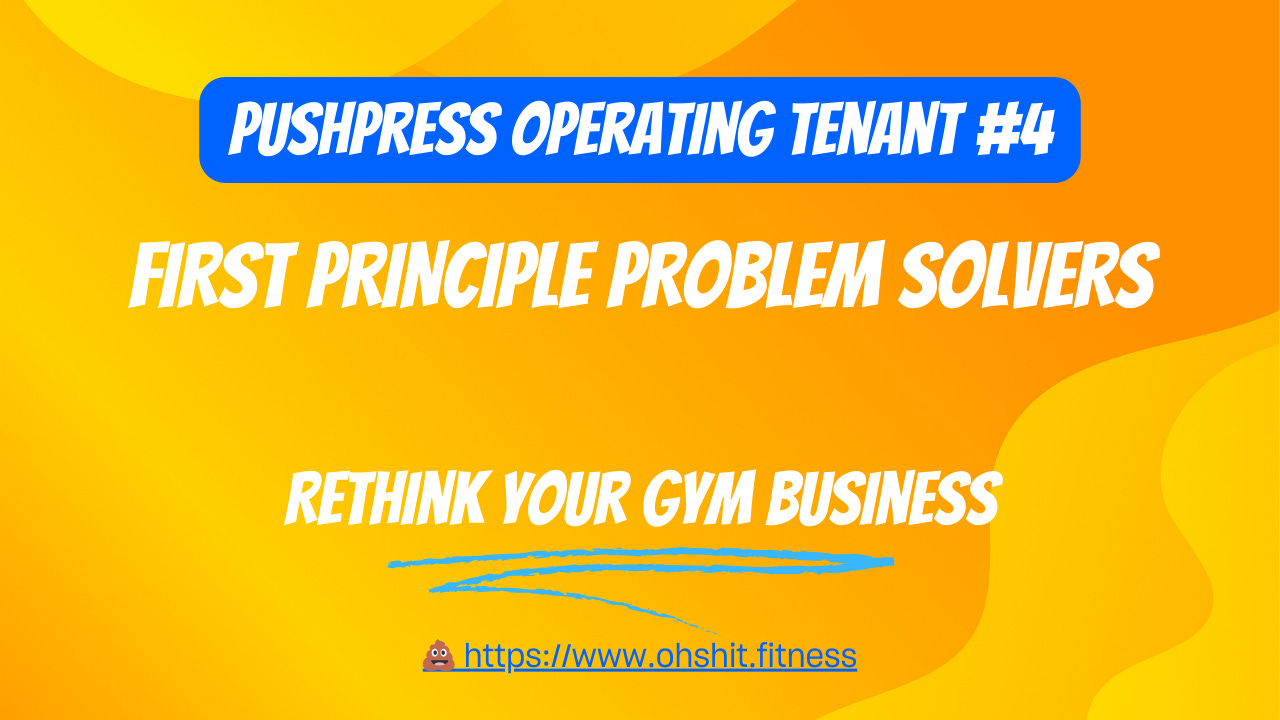PushPress Operating Tenet #4: First Principle Problem Solvers
Stop being lazy. Think big and solve existing problems in new ways.
Estimated Read Time: 4 minutes
TLDR: Most businesses settle for incremental improvements to old problems. That's lazy thinking. At PushPress, we strip away assumptions, examine fundamental truths, and build breakthrough solutions from scratch. This isn't just innovation—it's reinvention.
Recap: We Dropped Core Values for Operating Tenets
At PushPress, we recently ditched Core Values because we needed principles that would guide real actions, not just feel-good statements. As we've grown from scrappy startup to serving hundreds of gyms, we needed a framework that would help us execute better.
Today's Tenant: First Principle Problem Solvers
What "First Principle Problem Solving" Really Means
Here's our definition:
"We break big problems down to their core truths, question assumptions, and seek deeper understanding. We don't just accept how things have been done — we find better ways to operate. We embrace curiosity, continuous learning, and experimentation to drive innovation and refine our approach over time."
This isn't about reinventing the wheel for its own sake. It's about questioning everything to find the best solution, not just the conventional one.
Why This Matters to Our Business
I’ll admit. I have a massive chip on my shoulder.
When I opened my gym as an ex-software engineer, I realized really quickly that the software out there:
Didn’t understand gym ownership.
Were just building “things” to sell, not things of true value.
For this reason - from day one - First Principled thinking was core to who we were. If we copied what was out there in 2013, we would have built something equally unhelpful and unimaginative.
The truth is - most companies are copycats. This is because most companies are fixated on making a quick buck, not doing the hard things to understand their customers and solve their pain.
This creates bland solutions with marginal value. We strive to change our industry and help our clients in ways they themselves cannot even imagine yet.
To be this force of change, we must think bigger. We must think differently.
We must:
Break down problems to their fundamental components
Challenge industry assumptions about what gym owners really need
Ask "why" repeatedly until we reach core truths
Test our hypotheses with real-world experiments
What This Means for Your Gym
Let me be straight with you: First principle thinking isn't about reinventing everything in your gym. That's a recipe for chaos.
It's about knowing when to follow proven paths and when to question them.
The most successful gyms we work with apply first principles selectively to solve their biggest challenges:
1. They challenge broken assumptions When 2020Fit said they were going to buy an abandoned post office and go full send with a premium boutique concept - people thought "there’s no way they can cover that kind of overhead”. Jon Rowly built his own plan and confidence in his ability to execute and today they have a bustling community that fills up their CrossFit, boxing, bootcamp, yoga, and recovery programs. Question what's "impossible" in your market.
2. They inspect where they’re missing Instead of copying other gyms' member parties, one owner I was speaking to broke down why people really quit: they weren’t building the right expectations early into their member’s minds. They rebuilt their entire onboarding - properly setting expectations - and saw 40% higher 180-day retention.
3. They simplify complex problems The world's best coaches simplify complicated body movements into patterns the average client can perform and understand. Business is no different. Top gym owners break down complex challenges into fundamental components, making the path forward clear and actionable for their entire team.
The gym industry is full of "best practices" that aren't best for YOUR gym. Your market, your coaches, your members are unique. First principle thinking helps you see which rules to follow and which to rewrite.
Simple Ways to Build First Principle Thinking in Your Gym
Ready to think differently? Start here:
1. Practice the "Five Whys" technique When facing a challenge, ask "why" five times to get to the root cause. For example: "Why are members dropping out after three months?" Each answer leads to a deeper "why" until you reach fundamental truths.
2. Question one industry "truth" each week Pick a standard “truth” you hear everyone talk about as fact and ask: "How can I approach this from a different angle"?” “What does the world look like if I approach this differently?"
3. Build learning time into your schedule Dedicate 30 minutes daily to understanding fundamentals, not just tactics. Read books outside the fitness industry to gain fresh perspectives. Perspective opens all possibilities.
The Bottom Line
At PushPress, first principle thinking helps us build solutions that actually solve meaningful problems, not just copy competitors.
For gym owners, this approach is equally powerful. It helps you create unique value propositions that others can't easily replicate. It leads to genuine innovations in member experience, not just surface-level differentiation.
That's what first principle problem solving delivers – the ability to see opportunities others miss and build solutions that truly stand out in a crowded market.
When you master this skill, you stop following industry trends and start creating them.
Tomorrow: The last tenant in “how we think” - "Operating Tenet #5: Company-First Mindset"


